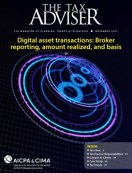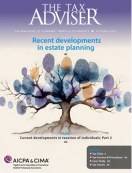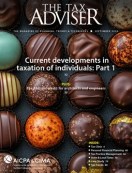- newsletter
- TAX INSIDER

Small businesses and related-party transactions
A taxpayer found out the hard way that transactions between companies he controlled must be properly treated and documented.
Please note: This item is from our archives and was published in 2018. It is provided for historical reference. The content may be out of date and links may no longer function.
Related
Third-party verification requests
Inventory accounting for cannabis businesses: Sec. 280E and the impact of tax reform
Why small business owners should have a qualified retirement plan
A recent Tax Court case highlights pitfalls frequently encountered by small businesses that engage in related-party transactions without appropriate planning. Povolny Group, Inc., T.C. Memo. 2018-37, an engaging opinion by Judge Mark V. Holmes, provides a helpful case-study of the following four issues:
- Whether an entity’s repayment of the debt of its sister entity constitutes a fresh loan between the entities, or a contribution to the second entity’s capital;
- Whether a contribution of capital constitutes a constructive dividend to the common shareholder;
- Whether to treat the dividend as a distribution, or as wages subject to employment taxes; and
- Whether an entity that makes payments on behalf of a sister entity is entitled to a bad-debt deduction, when the sister entity does not subsequently reimburse the entity that made those payments.
Facts
James Povolny, described by the court as “an ambitious and accomplished real-estate entrepreneur,” owned three S corporations: Povolny Group (PG), Archetone Limited (AL), and Archetone International (AI). When AL and AI underwent financial difficulties (“the phones just stopped ringing”), Povolny used PG’s funds to pay AL’s and AI’s debts. Povolny also engaged in various other related-party transfers. Povolny did not appreciate the tax ramifications of moving funds between distinct entities; rather than determine the legal status of the transfers and ensure appropriate documentation, he “treated legally separate corporations as one big wallet” (Povolny at *12).This created various tax issues, each of which the court analyzed in turn.
Whether an entity’s repayment of its sister entity’s debt is a loan or a contribution to capital
Over the course of several years, PG paid up several hundred thousand dollars of AL’s and AI’s debts. Although Povolny didn’t “see the merit” in creating formal notes or other documentation when he began moving money, he later claimed these payments were loans from PG to AL and AI.
The Tax Court examined these transactions and applied the traditional factors used to assess whether a transfer of funds creates a bona fide debt. A bona fide debt arises “from a debtor-creditor relationship based upon a valid and enforceable obligation to pay a fixed or determinable sum of money” (Povolny at *9, citing Regs. Sec. 1.166-1(c)). This relationship hinges on whether there was a “genuine intention to create a debt, with a reasonable expectation of repayment,” that comports with the economic reality; which in turn hinges on “a small forest of factors”:
- The names given to the certificates evidencing the indebtedness;
- The presence or absence of a fixed maturity date;
- The source of payments;
- The right to enforce payments;
- Whether there was participation in management as a result of the advances;
- The status of the advances in relation to regular corporate creditors;
- The intent of the parties;
- Any identity of interest between creditor and stockholder;
- Any “thinness” of capital structure in relation to debt;
- The “ability of [the] corporation to obtain credit from outside sources”;
- The “use to which [the] advances were put”;
- Any “failure of [the] debtor to repay”; and
- The “risk involved in making [the] advances.”
The court held that because PG didn’t execute a note, set an interest rate, ask for security, or set a maturity date, and because AL and AI were insolvent when PG made the payments, the payments were not loans, but rather capital contributions.
Whether the capital contribution was a constructive dividend
After finding that the transfers were capital contributions from PG to AL and AI, the court next examined whether these contributions were constructive dividends from PG to Povolny, and thus taxable income. A constructive dividend occurs when “a corporation confers an economic benefit on a shareholder without the expectation of repayment.” Accordingly, “a transfer between related corporations can be a constructive dividend to common shareholders even if those shareholders don’t personally receive the funds.” The transfer is a constructive dividend if “the common shareholder has direct or indirect control over the transferred property and the transfer wasn’t made for a legitimate business purpose but instead primarily benefited the shareholder.”
The court held that because (1) Povolny had control over all three companies, (2) the transfer from PG conferred an economic benefit on Povolny by reducing AL’s and AI’s liabilities, and (3) there was no expectation of repayment, the payment constituted a taxable constructive dividend to Povolny.
Whether the constructive dividends are wages subject to employment taxes
After finding the payments constituted constructive dividends, the court next considered whether to treat them as dividends or as wages.
A corporation that pays shareholder-employees must generally determine whether to classify the payments as distributions or wages. Among other ramifications, payments classified as wages generate employment taxes, unlike payments classified as dividends.
The court stated that whether payments to an employee-shareholder are wages paid for services or something else (such as dividends or a loan repayment) is a question of fact. Rather than accepting the name the parties give a payment, courts instead focus on the substantive intent of the payment, which largely hinges on what compensation would be reasonable for the employee’s services (Povolny at *21, citing Watson, P.C., 668 F.3d at 1016–17; Rev. Rul. 74-44). Factors include:
- The employee’s qualifications;
- The nature, extent, and scope of the employee’s work;
- The size and complexities of the business;
- A comparison of salaries paid with the company’s gross income and net income;
- The prevailing general economic conditions;
- Comparison of salaries with distributions to stockholders;
- The prevailing rates of compensation for comparable positions in comparable concerns;
- The salary policy of the taxpayer as to all employees; and
- In the case of small corporations with a limited number of officers , the amount of compensation paid to the particular employee in the previous years (Povolny at *21–2, citing Charles Schneider & Co., 500 F.2d 148, 151–52 (8th Cir. 1974), aff’g T.C. Memo. 1973-130).
Applying these factors, the court held that the payments to Povolny clearly constituted wages, for which he owed employment taxes.
Whether an entity that makes payments on a sister entity’s behalf is entitled to a bad-debt deduction
Povolny also claimed a $290,000 loss stemming from a bad-debt deduction taken by AL, for loan repayments AL made on behalf of AI. According to Povolny, AL’s payments on behalf of AI constituted a new loan to AI, and AL subsequently was entitled to a deduction because AI was unable to pay those loans.
The court identified two requirements for a bad debt deduction: (1) there must be a bona fide debt, and (2) where there is a bona fide debt, the worthlessness of the debt can be demonstrated in the year the deduction is claimed (Povolny at *15, citing Regs. Sec. 1.166-1(c) and Sec. 166(a)(1)). Under these criteria, the court found no formal signs of the existence of a debt — “the underlying economics of the situation strongly suggests that Povolny was once again just using one of his companies’ funds to pay another of the companies’ debts” (Povolny at *18).
The court also examined the rules for worthlessness of debt. For a debt to be worthless, the taxpayer must show “identifiable events that form the basis of reasonable grounds for abandoning any hope of recovery.” Criteria include:
- A decline in the debtor’s business;
- A decline in the value of the debtor’s assets;
- Overall business climate;
- The debtor suffers serious financial hardship;
- What the debtor’s earning capacity is;
- Events of default;
- The debtor’s insolvency;
- The debtor’s refusal to pay;
- Actions taken by the creditor to pursue collection; and
- Subsequent dealings between the creditor and the debtor.
Applying these factors, the court held that Povolny failed to support his claim of the debt’s worthlessness.
Transactions between related parties should be properly treated and documented
As noted by the court, “taking money from one corporation and routing it to another will almost always trigger bad tax consequences unless done thoughtfully.” Tax practitioners should closely scrutinize transactions between related entities to ensure proper treatment, and carefully adhere to documentation policies to support positions taken.
Joseph A. Wiener, J.D., LL.M., practices in New York City. To comment about this article or to suggest an idea for another article, please contact Sally Schreiber, senior editor, at Sally.Schreiber@aicpa-cima.com.














